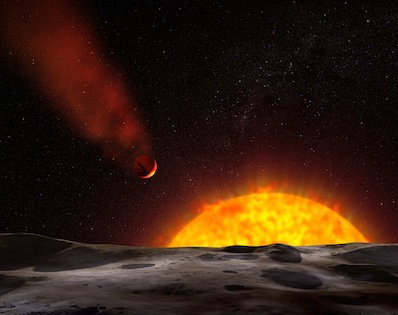


|

|
 |
|
"Ping-pong" planets bounce between stars DR EMILY BALDWIN ASTRONOMY NOW Posted: 07 February 2012 A gravitational ping-pong match lasting up to one million years could be in play between nearby binary stars, say Cambridge University scientists. It is widely accepted that planets can be ejected completely from a solar system, especially during the dynamically chaotic period early in the solar system's life where planets are jostling for the most stable orbits (see Jumping Jupiter ejected giant planet and Free-floating planets more common than stars?). Recently, exoplanets have been found in two and even three-star systems, and in the new study, Nickolas Moeckel and Dimitri Veras of the Institute of Astronomy, Cambridge, show that a planet ejected from orbit around one star could find itself passed onto its binary companion. Furthermore, the planet may get "bounced" between the stars, providing one possible explanation for the eccentric orbits of some exoplanets.  Planets could be kicked out of one star's clutches only to be sent careening around – or even into – its binary companion. Image: NASA, ESA, and G. Bacon (STScI). Moeckel explains that there are two key elements required for this phenomenon. "First, the stars need to be on a wide enough orbit so that one is not interfering with planet formation around the other," he says, stressing that this is distinctly different to the recently announced 'Tatooine'-like planets, where the planets are in orbit around both stars of a closely separated binary (see Planets discovered with double Sun-like stars). "Second, there need to be multiple planets around one of the stars. The orbital instability that leads to the bouncing phenomenon requires that two planets come in close proximity to each other – this happens more easily and faster with multiple closely spaced planets." In the new computer models, the bouncing effect typically occurs for stars separated by between six and 25 times the distance between the Sun and Pluto. Up to 85 percent of the ejected planets will make at least one journey through the companion star's space, and between 45 and 75 percent will bounce repeatedly, depending on the initial orbital parameters of both systems. "Rarely a planet that begins bouncing will settle back into its original planetary system, but this is done at the expense of one of the other remaining planets, which will itself be ejected or collide with a planet or star," says Moeckel. "Once the bouncing begins, typically the planet will eventually end up leaving the binary system." This planetary ping-pong game lasts for up to one million years and could result in the stars swapping their planets. With such wildly erratic orbits, habitability of these planets is out of the question, with searing hot temperatures as the it swings around the host star, and freezing cold temperatures as it is flung back out into space. As for examples of this happening in the ever-growing exoplanet database, "we don't yet have enough observational constraints on the number of systems in nature that match our simulations to give a good estimate," says Moeckel. "We could see a planet in the process of bouncing if we were able to measure all parts of the binary system precisely, particularly if we notice the planet residing 'in-between' the two stars." The paper has been accepted for publication in MNRAS and was posted online on arXiv on 31 January. |
|
|
|
|